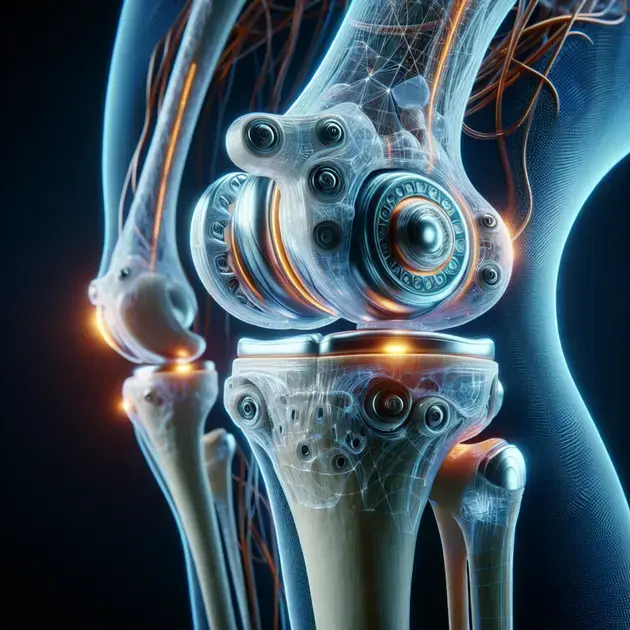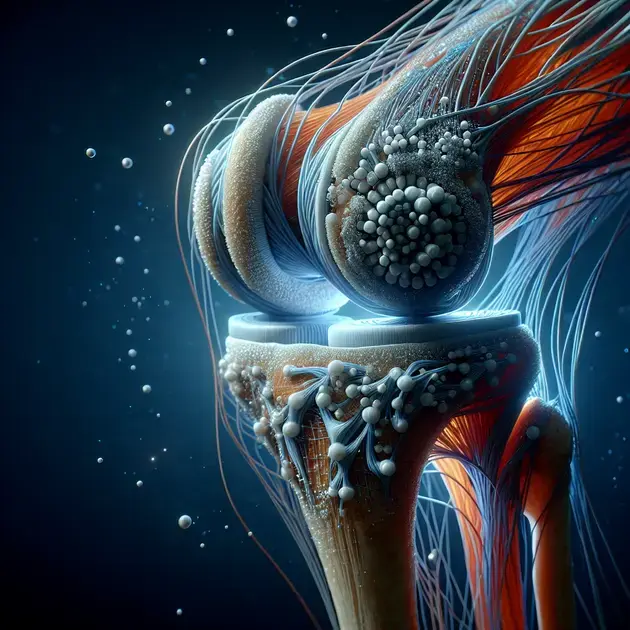Understanding the mechanics of the knee joint is essential in comprehending how this complex structure supports movement and functionality. The knee joint is one of the largest and most crucial joints in the human body, connecting the thigh bone (femur) to the shin bone (tibia). Its intricate design involves various components, including bones, cartilage, ligaments, and tendons, all working together to provide stability and range of motion.
A recent study published in the Journal of Orthopaedic Research delved into the biomechanics of the knee joint, shedding light on the dynamic interactions between its different parts during movement. This research highlighted the significance of understanding how forces are distributed and absorbed by the knee during activities such as walking, running, and jumping. By gaining insights into the mechanical behavior of the knee joint, healthcare professionals can improve diagnostic accuracy and develop more effective treatment strategies for related injuries and conditions.
The Complexity of the Knee Joint Structure
Understanding the complex structure of the knee joint is essential for diagnosing and treating various knee-related conditions. The knee joint is the largest joint in the human body, composed of bones, ligaments, tendons, and cartilage. The main components of the knee joint include the femur (thigh bone), tibia (shin bone), fibula, patella (kneecap), and the meniscus.
To explore the intricacies of the knee joint structure, one can utilize interactive anatomy apps such as “Complete Anatomy” and “Essential Skeleton 4.” These apps provide detailed 3D models of the knee joint, allowing users to visualize the bones, ligaments, and other structures in great detail. By rotating and zooming in on the virtual model, individuals can gain a better understanding of how each component contributes to the overall function of the knee joint.
Examining the complexity of the knee joint structure also involves learning about the biomechanics of movement. Apps like “My Jump 2” and “Dartfish Express” offer tools for analyzing motion and tracking joint angles during activities like running, jumping, and squatting. By studying the biomechanical aspects of knee joint movement, healthcare professionals can identify potential issues related to muscle strength, alignment, and stability.
Furthermore, educational websites like OrthoInfo.org and Physiopedia.com provide in-depth articles and resources on the anatomy and function of the knee joint. These platforms offer valuable insights into the structural nuances of the knee, explaining how different components work together to support mobility and stability.
In conclusion, delving into the complexity of the knee joint structure requires utilizing various tools and resources to enhance knowledge and understanding. By leveraging anatomy apps, motion analysis tools, and educational websites, individuals can deepen their insights into the intricate design of the knee joint.
Exploring the Biomechanical Dynamics of the Knee
Exploring the biomechanical dynamics of the knee involves investigating how forces and movements impact the function and health of this vital joint. The knee joint is subjected to significant stress during everyday activities such as walking, running, and bending, making it crucial to understand the biomechanics involved in knee motion.
One way to explore the biomechanical dynamics of the knee is through gait analysis software like “Delsys Trigno Motion” and “APDM Mobility Lab.” These tools enable researchers and healthcare professionals to assess gait patterns, joint angles, and muscle activity during walking and running. By analyzing these biomechanical parameters, insights can be gained into issues such as gait abnormalities, muscle imbalances, and joint loading.
Additionally, biomechanics simulation software such as “AnyBody Modeling System” and “OpenSim” allow for the creation of virtual musculoskeletal models to study knee joint dynamics. These simulations help researchers predict the effects of different forces on the knee joint, providing valuable data for designing interventions and treatments for knee injuries.
Exploring the biomechanical dynamics of the knee also involves understanding concepts like joint kinematics, kinetics, and muscle activation patterns. Online platforms like ResearchGate and Google Scholar offer access to research articles and studies on knee biomechanics, allowing individuals to stay updated on the latest findings and advancements in the field.
In summary, delving into the biomechanical dynamics of the knee requires utilizing advanced software tools, simulation models, and research resources to gain insights into how forces and movements affect the function and health of the knee joint.
Enhancing Diagnostic Capabilities Through Mechanical Insights
Enhancing diagnostic capabilities through mechanical insights involves utilizing biomechanical knowledge and technologies to improve the assessment and diagnosis of knee-related conditions. By integrating mechanical insights into diagnostic processes, healthcare professionals can achieve more accurate and targeted evaluations of knee issues.
One approach to enhancing diagnostic capabilities is through the use of diagnostic imaging tools like MRI (Magnetic Resonance Imaging) and CT (Computed Tomography) scans. These imaging modalities provide detailed views of the knee joint structure and can reveal abnormalities in bones, cartilage, ligaments, and other tissues. By interpreting these images with a biomechanical perspective, clinicians can gain valuable insights into the mechanical factors contributing to knee problems.
Furthermore, wearable sensors and biomechanical analysis systems such as “DynaPort,” “Gait Up,” and “OptoGait” allow for real-time monitoring of knee movements and forces during activities. These devices provide objective data on gait parameters, joint loading, and movement patterns, enabling more precise assessments of knee function and performance.
Integrating mechanical insights into diagnostic capabilities also involves utilizing computational modeling and simulation techniques to predict the behavior of the knee joint under different conditions. Software tools like “SIMM” and “AnyBody Modeling System” enable researchers to simulate knee mechanics and test various treatment scenarios virtually before implementing them in clinical practice.
By combining imaging technologies, wearable sensors, and computational modeling, healthcare providers can enhance their diagnostic capabilities and tailor treatments to the specific mechanical needs of individual patients. This multidisciplinary approach leverages mechanical insights to improve the accuracy and effectiveness of knee diagnostics and interventions.
Understanding the Biomechanics of the Knee Joint
When it comes to understanding the biomechanics of the knee joint, it is crucial to dive deep into the complex structure and functionality of this vital joint. The knee joint is one of the largest and most intricate joints in the human body, responsible for supporting body weight, facilitating movement, and absorbing shock. It is composed of four main components: bones, cartilage, ligaments, and tendons, all working together seamlessly to provide stability and mobility.
The biomechanics of the knee joint involve a delicate balance between flexibility and strength. The bones that make up the knee joint, including the femur, tibia, and patella, form a complex network of interlocking structures that allow for smooth and controlled movements. The cartilage within the joint acts as a cushion, absorbing impact and reducing friction during motion.
Ligaments play a crucial role in stabilizing the knee joint, connecting the bones and preventing excessive movement. Tendons, on the other hand, connect muscles to bones, enabling the knee to move effectively. Understanding the biomechanics of the knee joint is essential for diagnosing and treating various conditions that can affect its function, such as arthritis, ligament injuries, and cartilage damage.
By studying the biomechanics of the knee joint, healthcare professionals can develop targeted treatment plans that address specific issues and improve overall joint health. From physical therapy exercises to surgical interventions, a thorough understanding of knee joint biomechanics is the cornerstone of effective treatment strategies.
Examining the Functionality of Knee Mechanics
Examining the functionality of knee mechanics involves analyzing how the various components of the knee joint work together to support movement and bear load. The mechanics of the knee joint are highly intricate, relying on a combination of muscle strength, ligament stability, and joint flexibility to function optimally.
One key aspect of knee mechanics is the role of the quadriceps and hamstrings muscles in supporting joint movement. These muscles work in tandem to flex and extend the knee, allowing for actions such as walking, running, and jumping. The patella, or kneecap, also plays a crucial role in knee mechanics, acting as a fulcrum to increase the efficiency of muscle force.
Ligaments, including the ACL, PCL, MCL, and LCL, provide vital stability to the knee joint during various activities. Injuries to these ligaments can significantly impact knee functionality and require specialized treatment approaches to restore joint mechanics. Understanding how these ligaments interact with the other components of the knee joint is essential for developing effective rehabilitation programs.
By examining the functionality of knee mechanics, healthcare providers can tailor treatment approaches to address specific mechanical issues and improve overall joint function. From strengthening exercises to biomechanical assessments, a comprehensive understanding of knee mechanics is essential for optimizing patient outcomes and promoting long-term joint health.
Improving Treatment Approaches with Mechanical Knowledge
Improving treatment approaches for knee injuries and conditions requires a deep understanding of the mechanical forces at play within the joint. By applying mechanical knowledge to treatment strategies, healthcare professionals can develop targeted interventions that address the root cause of knee issues and promote healing.
One effective way to improve treatment approaches is by utilizing advanced imaging techniques, such as MRI and CT scans, to visualize internal structures and assess joint mechanics. These tools can provide valuable insights into the nature and extent of knee injuries, guiding the development of personalized treatment plans.
Another key aspect of enhancing treatment approaches is through biomechanical analysis, which involves studying how forces interact within the knee joint during movement. By analyzing gait patterns, muscle activation, and joint alignment, clinicians can identify biomechanical abnormalities and implement corrective measures to improve joint function.
Furthermore, incorporating principles of biomechanics into rehabilitation programs can help optimize recovery and prevent future injuries. By targeting muscle imbalances, improving joint stability, and promoting proper movement patterns, patients can regain function and mobility more effectively.
Overall, improving treatment approaches with mechanical knowledge is essential for delivering comprehensive care to individuals with knee injuries. By integrating biomechanical principles into diagnosis, treatment, and rehabilitation, healthcare providers can offer personalized and effective solutions that address the unique mechanical needs of each patient.
Conclusion
In conclusion, understanding the biomechanics of the knee joint is paramount for healthcare professionals and patients alike. The intricate interplay between bones, cartilage, ligaments, and tendons forms the foundation of knee functionality, enabling smooth movement, stability, and shock absorption. By delving deep into the complexities of the knee joint, individuals can diagnose and treat conditions like arthritis or ligament injuries more effectively.
Examining the functionality of knee mechanics sheds light on the importance of muscle strength, ligament stability, and joint flexibility in supporting movement and load-bearing. The coordinated efforts of quadriceps, hamstrings, and crucial ligaments like ACL and PCL are essential for optimal knee function. Through tailored treatment approaches, healthcare providers can address mechanical issues and enhance overall joint health for improved patient outcomes.
Improving treatment approaches with mechanical knowledge is a pivotal step towards comprehensive care for knee injuries. Advanced imaging techniques and biomechanical analysis offer valuable insights into the root causes of knee issues, guiding personalized treatment plans and rehabilitation programs. By integrating biomechanical principles into every stage of care, healthcare professionals can provide effective solutions that meet the unique mechanical needs of each patient, promoting long-term joint health and mobility.

